AMD Zen 4 Ryzen 9 7950X and Ryzen 5 7600X Review: Retaking The High-End
by Ryan Smith & Gavin Bonshor on September 26, 2022 9:00 AM ESTCPU Benchmark Performance: Simulation And Encoding
Simulation and Science have a lot of overlap in the benchmarking world, however for this distinction we’re separating into two segments mostly based on the utility of the resulting data. The benchmarks that fall under Science have a distinct use for the data they output – in our Simulation section, these act more like synthetics but at some level are still trying to simulate a given environment.
One of the interesting elements on modern processors is encoding performance. This covers two main areas: encryption/decryption for secure data transfer, and video transcoding from one video format to another.
In the encrypt/decrypt scenario, how data is transferred and by what mechanism is pertinent to on-the-fly encryption of sensitive data - a process by which more modern devices are leaning to for software security.
Video transcoding as a tool to adjust the quality, file size and resolution of a video file has boomed in recent years, such as providing the optimum video for devices before consumption, or for game streamers who are wanting to upload the output from their video camera in real-time. As we move into live 3D video, this task will only get more strenuous, and it turns out that the performance of certain algorithms is a function of the input/output of the content.
We are using DDR5 memory on the Ryzen 9 7950X and Ryzen 5 7600X, as well as Intel's 12th Gen (Alder Lake) processors at the following settings:
- DDR5-5200 CL44 - Ryzen 7000
- DDR5-4800 (B) CL40 - Intel 12th Gen
All other CPUs such as Ryzen 5000 and 3000 were tested at the relevant JEDEC settings as per the processor's individual memory support with DDR4.
Simulation
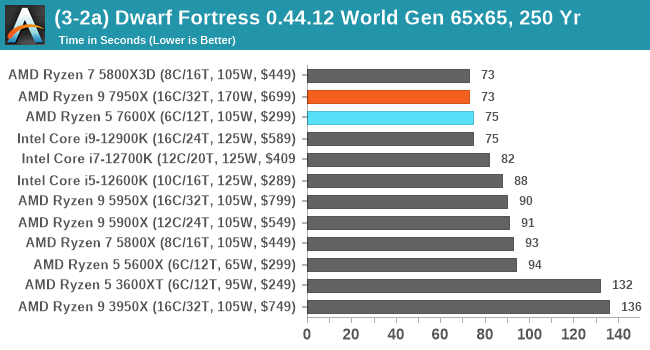
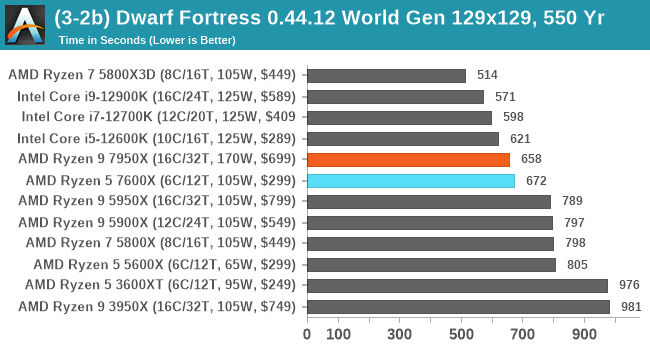
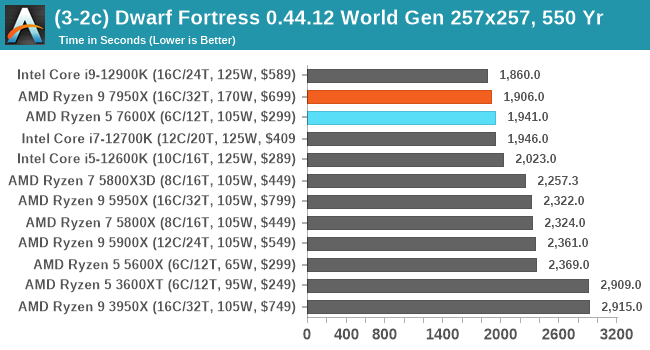
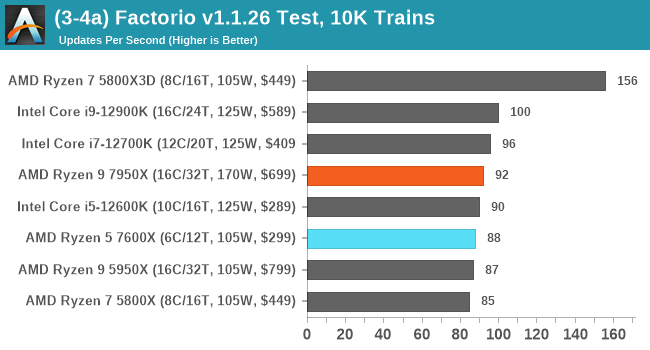
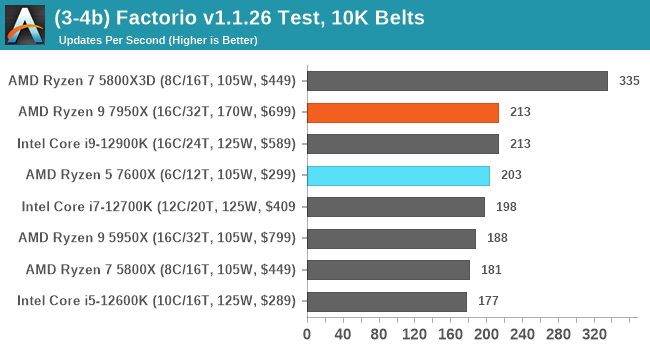
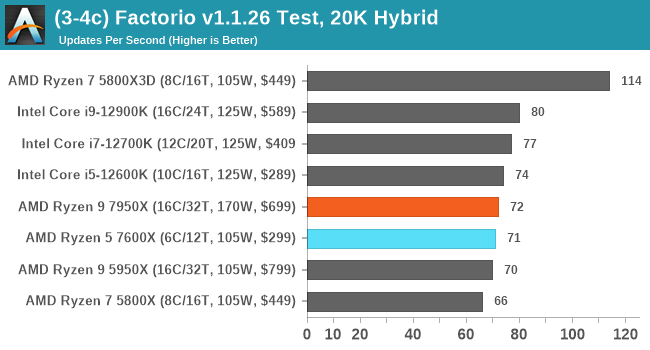
Starting with the Dwarf Fortress section of our simulation suite, the performance of the Ryzen 9 7950X and Ryzen 5 7600X is inconsistent, to say the least. In the smaller of our three Dwart Fortress tests, there's around 2-3% difference between the Ryzen 7000 chips, the Core i9-12900K and Core i7-12700K, and AMD's impressive Ryzen 7 5800X3D with its incredibly large 96 MB pool of cache to play with.
In the larger Dwarf Fortress workloads, and the Alder Lake based Core i9-12900K, the Core i7-12700K and the Core i5-12600K show better scope for performance, with the exception being the Ryzen 7 5800X3D which due to its large 3D V-Cache, keeps the pressure on Intel.
Looking at performance in our Factorio benchmarks, the AMD Ryzen 7 5800X3D with its 3D V-Cache is streets ahead of the competition, with both the Ryzen 9 7950X and Ryzen 5 7600X both lagging behind considerably. Comparing Ryzen 7000 to Intel's Alder Lake, Alder Lake has the overall advantage here, even with the many optimizations and improvements that Zen 4 brings to the table.
Encoding
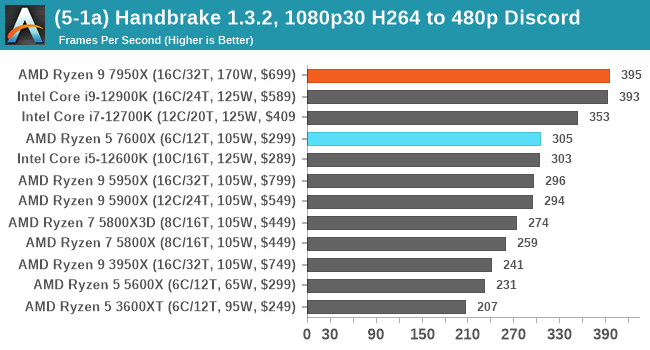
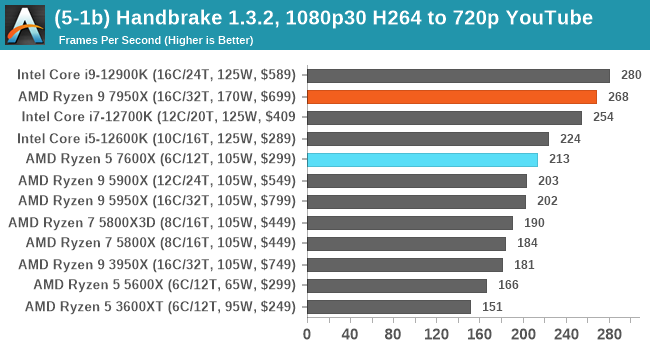
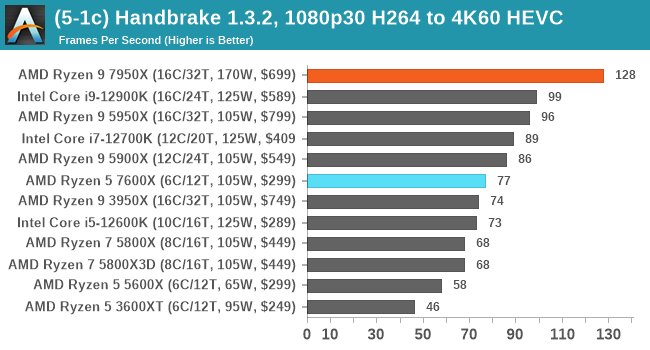
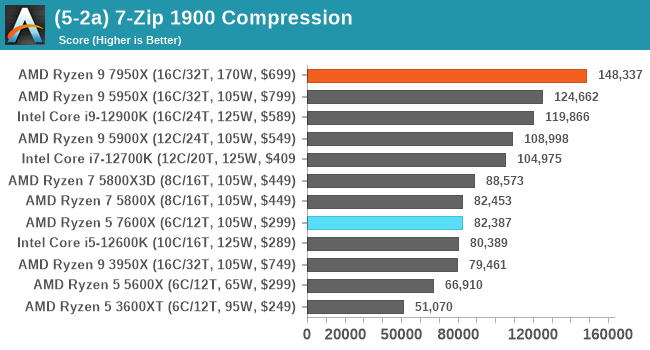
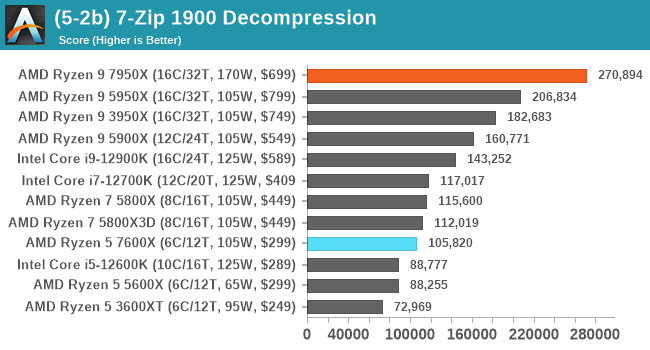
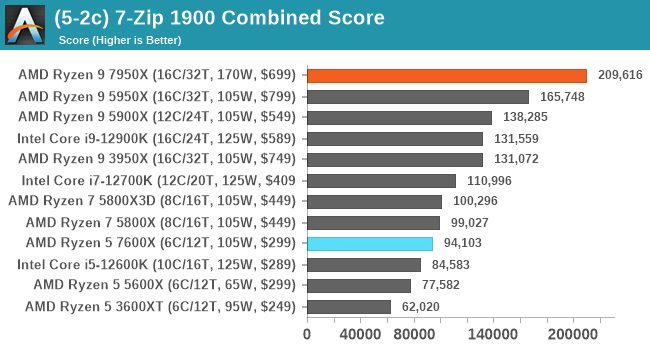
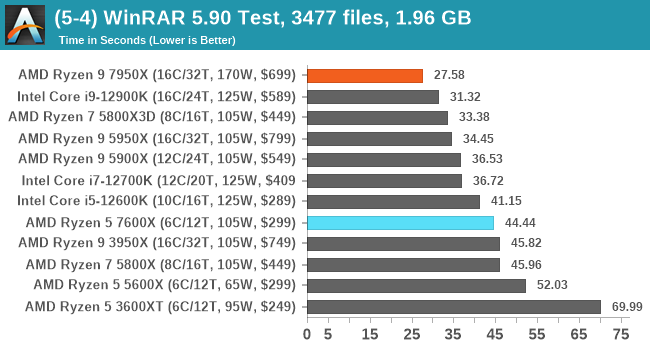
Focusing on encoding, and the Ryzen 9 7950X is the clear winner, beating the Core i9-12900K in all but one of the Handbrake tests (1080p30). The Ryzen 5 7600X trades blows with last generation Ryzen 7 5800X, which is an improvement within itself, as the Ryzen 5 5600X does lag behind the rest of the pack.










205 Comments
View All Comments
RomanPixel - Tuesday, September 27, 2022 - link
Me too! Replykmalyugin - Monday, September 26, 2022 - link
Wow, this article is almost unreadable. Was spellchecker turned off? Replyjonkullberg - Monday, September 26, 2022 - link
Gaming benchmarks with DDR5-6000 CL30 please! ReplyBushLin - Monday, September 26, 2022 - link
Exactly Replyxol - Monday, September 26, 2022 - link
wtf am I reading (context a part with tdp up to 170W from 105W) :"This has been possible through superior power efficiency, as Zencally a Zen 3 refinement, but on the new TSMC 5 nm process node (from TSMC 7 nm). This efficiency has allowed AMD to increase the overall TDP to 170 W from the previous 105 W but without too much penalty."
I can't even .. "too much penalty" ??
.. Looks like Zen has reached the end of the road imo (it had a good run) - none of the improvements here are from AMD - new DDR5, new 5nm node. The rest is "increase clocks/tdp" just like when Intel was stuck on 14nm.
I just don't know where they are going from here Reply
Threska - Monday, September 26, 2022 - link
Well we have " While Ryzen 7000 can drive a 2 DPC/4 DIMM setup, you’re going to lose 31% of your memory bandwidth if you go that route. So for peak performance, it’ll be best to treat Ryzen 7000 as a 1 DPC platform." and " Unfortunately, the compatibility situation is essentially unchanged from the AM4 platform, which is to say that while the CPU supports ECC memory, it’s going to be up to motherboard manufacturers to properly validate it against their boards.". The memory situation seems like a sticking point for a good while till things mature. ReplyBushLin - Monday, September 26, 2022 - link
Did you read the article? Put it in eco mode (105W for a 170W part) and it still stomps over everything in MT performance. Zen 4 is more about platform improvements, Zen 5 will be the microarchitecture overhaul. ReplyBushLin - Monday, September 26, 2022 - link
Stomping everything at 65W even! Replyxol - Tuesday, September 27, 2022 - link
Impressed that it's nominally $100 cheaper than a 5950X .Got to admit that. Replyxol - Tuesday, September 27, 2022 - link
Eco mode does perform better eg cinebench- b maybe +23% compared to 5950X, but it's using DDR5 5200 vs DDR4-3200 (?), and the power advantage can be assumed to come from 5nmMy original point still stands for me- 90% of benefits are from node and memory and allowing clocks as high as Tjunction allows - I don't think that is a great showing for AMD Reply